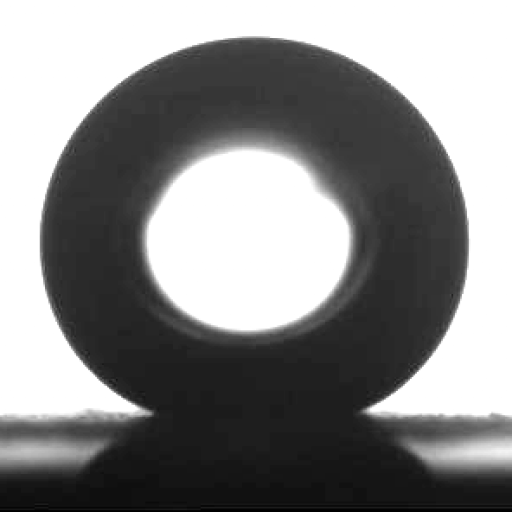Droplet and Contact Line Friction
A droplet on a perfectly smooth and chemically homogenous surface has a unique equilibrium contact angle. If its volume increases or decreases its contact radius smoothly increases or decreases to maintain the equilibrium contact angle. However practical surfaces have roughness and chemical heterogeneity and so a pinning force has to be overcome before the contact line can move. This results in contact angle hysteresis (CAH) – the difference between the maximum contact angle before a contact line advances and the minimum contact angle before the contact line recedes. In the liquid-on-solid Amontons’ laws, the coefficient of static friction is proportional to the CAH. The force to move a droplet is proportional to the product of the CAH and the normal component of the surface tension force.
The pinning force on a droplet of water on a Slippery Omniphobic Covalently-Attached Liquid-like (SOCAL) surface is easily overcome to set the droplet into motion. Amazingly, although droplets are easy to set into motion on this surface they move slowly and have a high coefficient of kinetic contact line friction, as seen in the video below (where the drop is moving, but very slowly).
The SOCAL coating is a hydroxy-terminated PDMS surface, and a simple molecular capping to convert to a trimethylsilyl-terminated PDMS surface results in a dramatic reduction in kinetic contact line friction. Drops move far more quickly on this surface, as seen in this video:
A molecular-capping (methylation) procedure can be used to convert the silanol-termination of the PDMS chains to trimethylsilyl-termination, which is called c-SOCAL. c-SOCAL surfaces have lower kinetic friction. The effectiveness of the molecular capping procedure depends on the process parameters used to create the surfaces, particularly the relative humidity (RH) because of the reactivity of the chlorotrimethylsilane used in the vapour phase methylation procedure to water vapour. The kinetic friction is significant reduced on a surface with RH=50% (called a c50-SOCAL surface). The video below shows droplet motion on SOCAL and c50-SOCAL surfaces tilted at two angles.
Publications
- Contact-angle hysteresis and contact-line friction on slippery liquid-like surfaces H. Barrio-Zhang, É. Ruiz-Gutiérrez, S. Armstrong, G. McHale, G. G. Wells and R. Ledesma‐Aguilar, Langmuir 36 (2020), 15094–15101
- Molecularly capped omniphobic polydimethylsiloxane brushes with ultra‐fast contact line dynamics B. Khatir, Z. Azimi Dijvejin, P. Serles, T. Filleter and K. Golovin, Small 19 (2023), 2301142
- Adhesive forces in droplet kinetic friction on liquid-like surfaces G. McHale, S. Janahi, H. Barrio-Zhang, Y. Wang, J. Chen, G. G. Wells and R. Ledesma-Aguilar Physical Review Letters 135 (2025), 2040031–2040037
